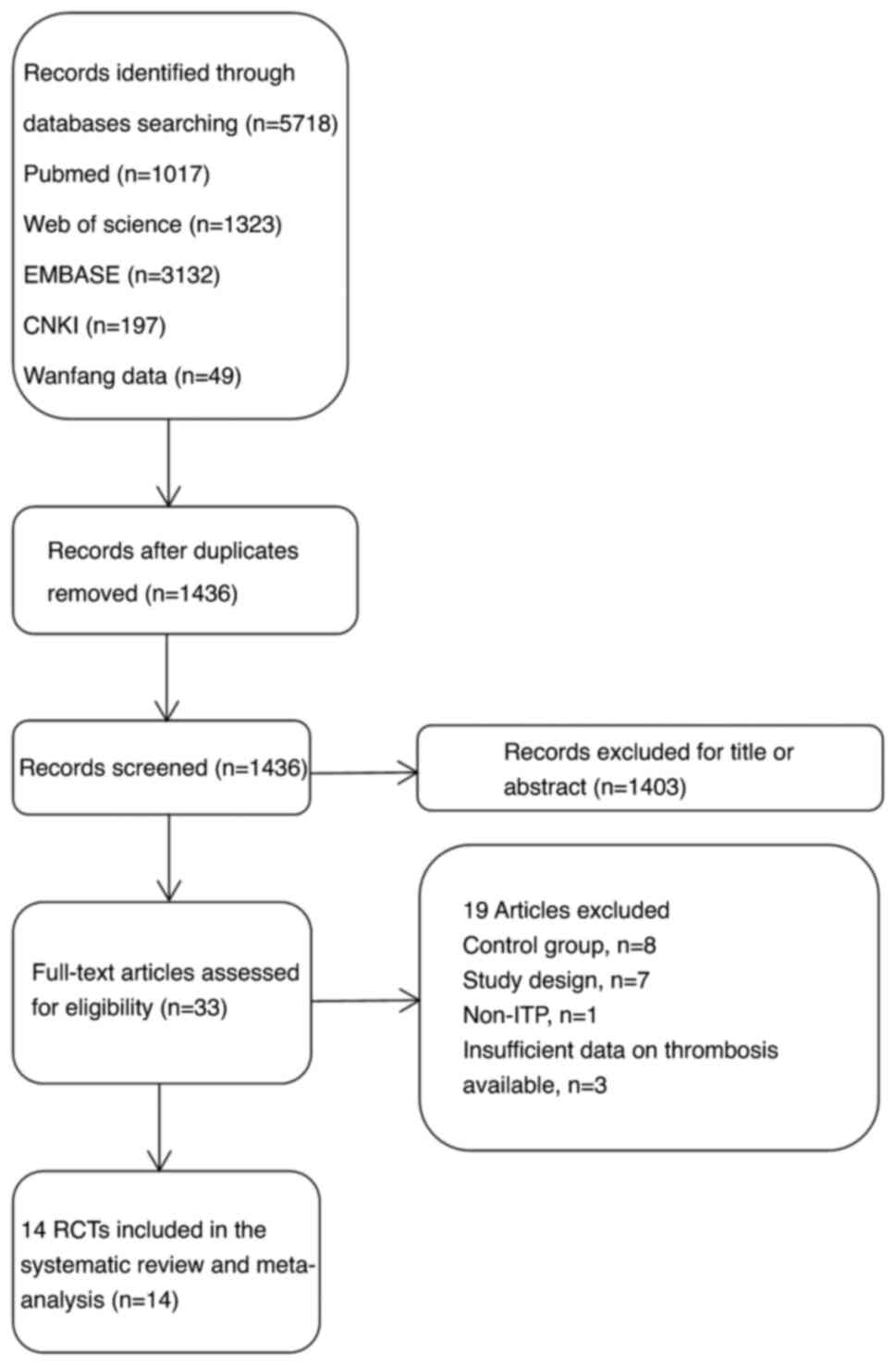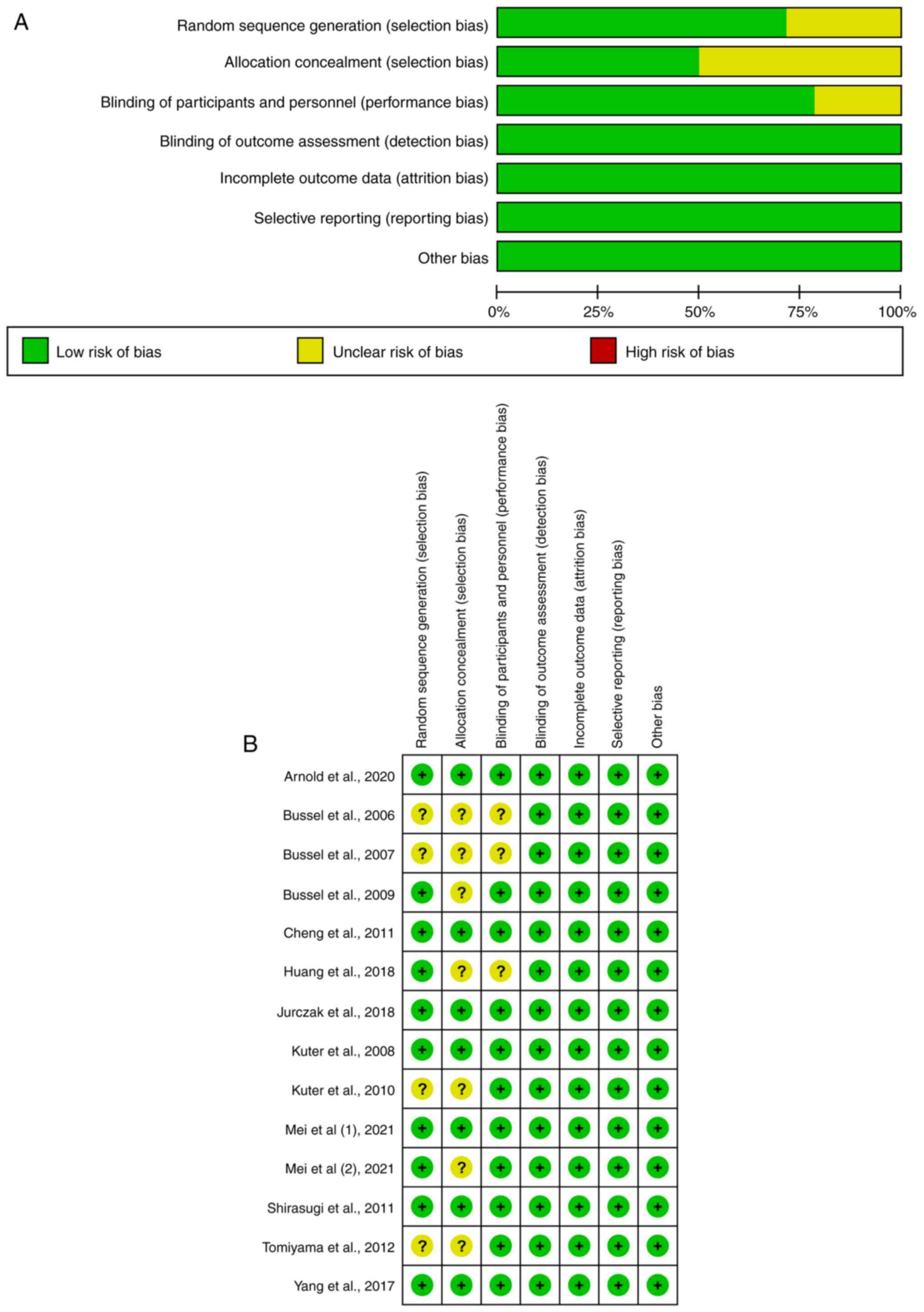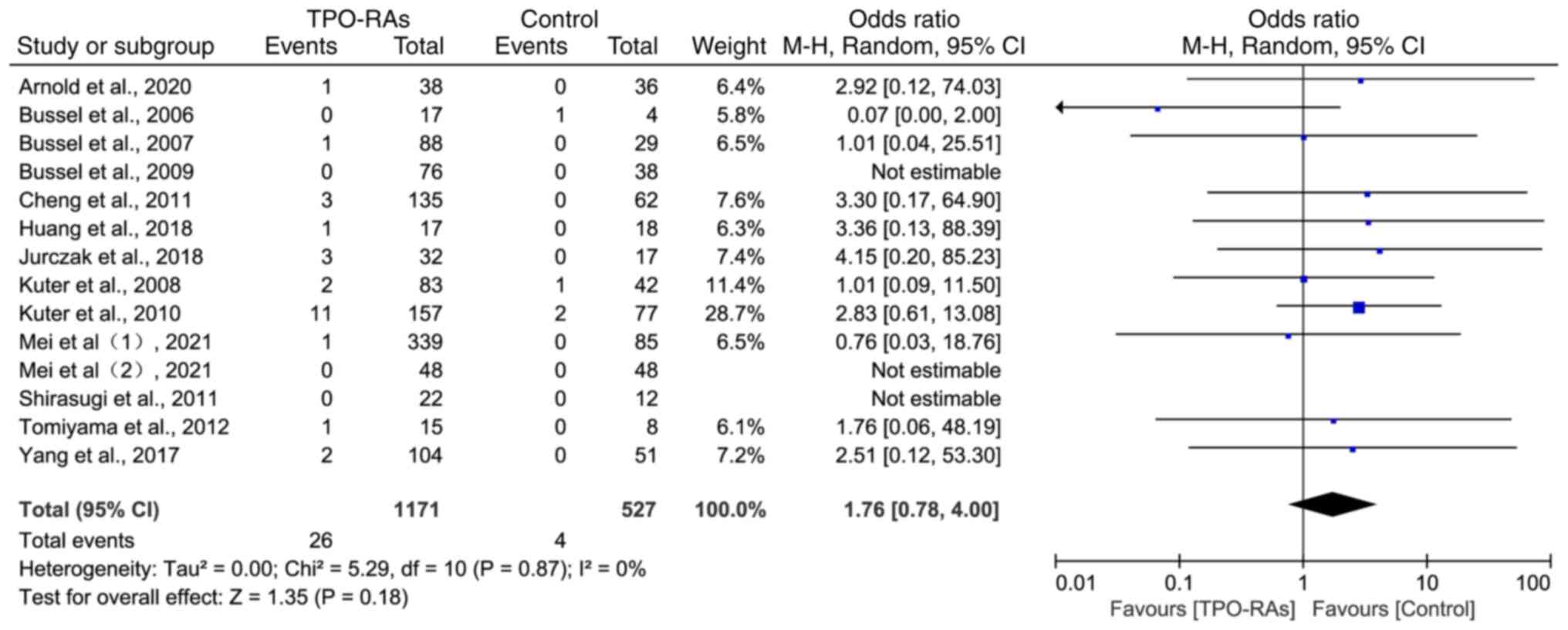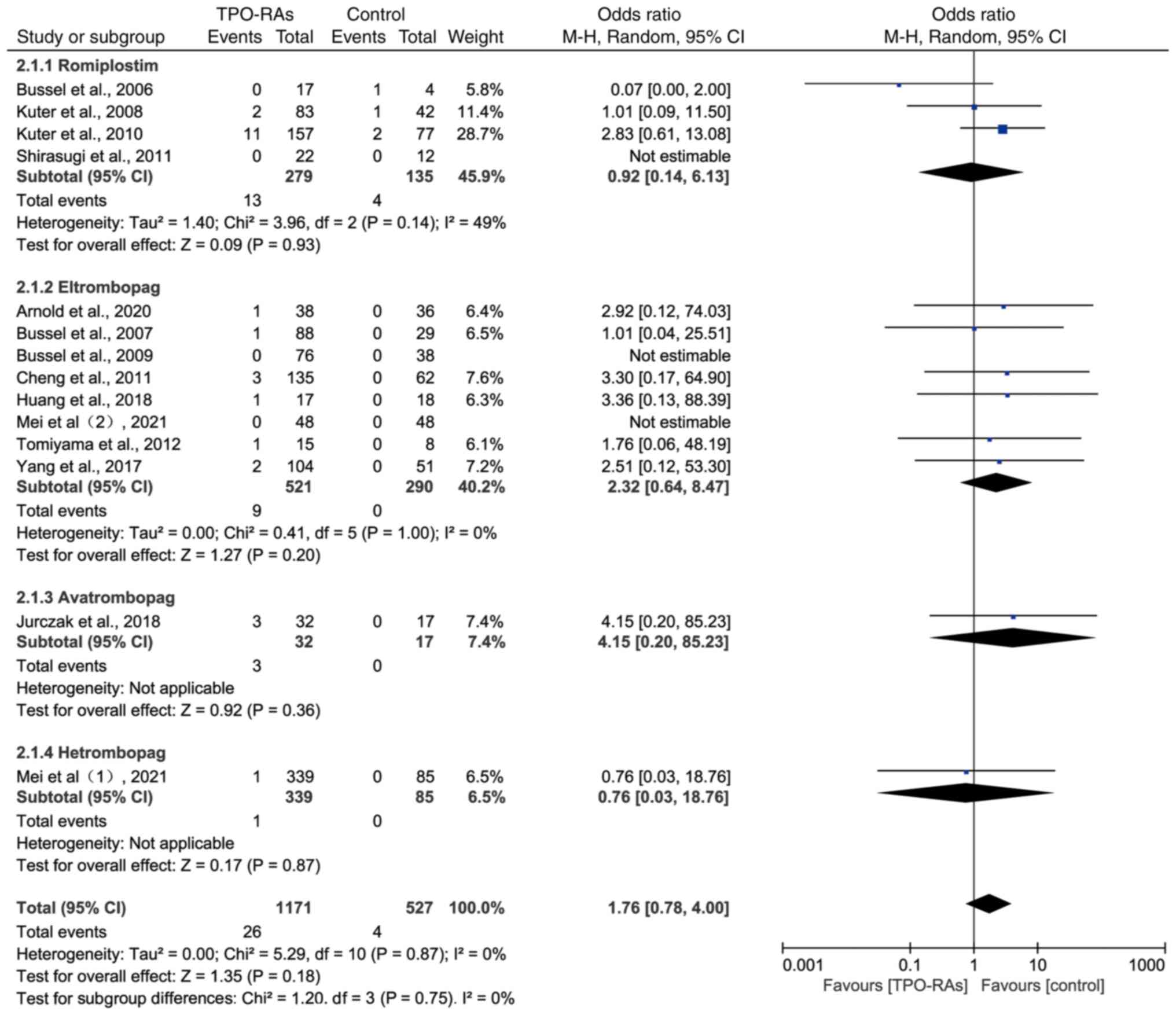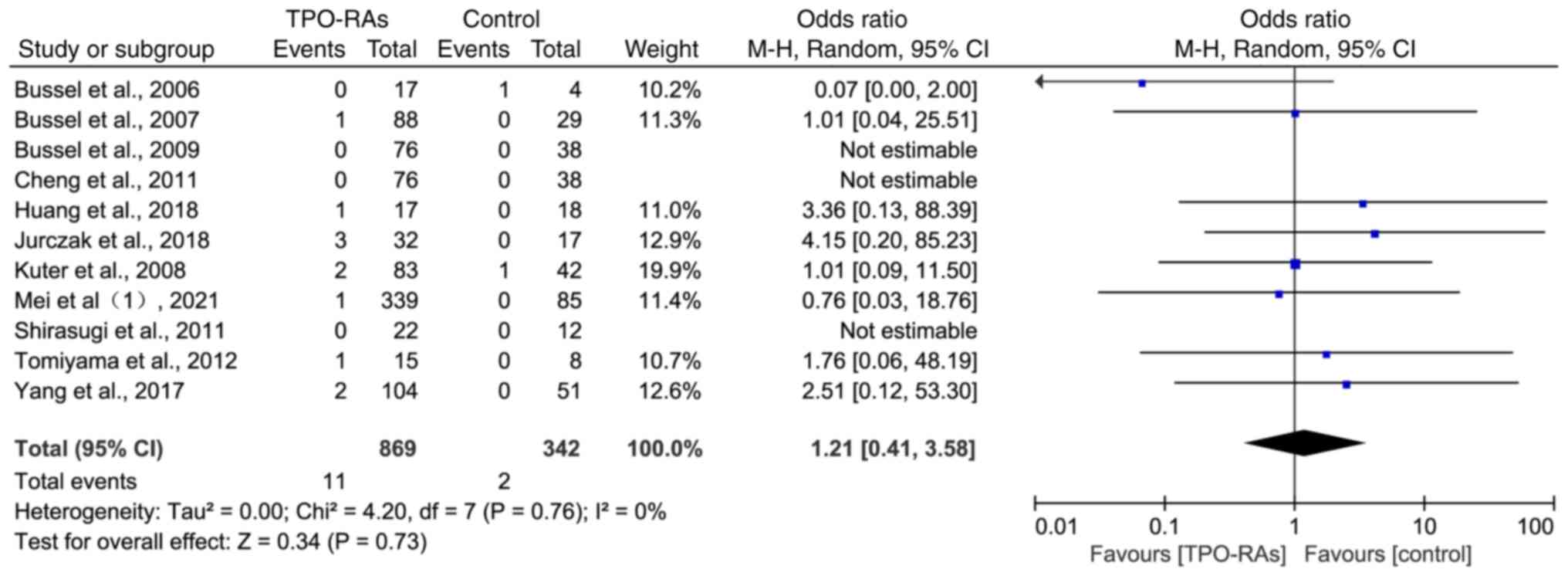Thrombopoietin receptor agonists use and risk of thrombotic events in patients with immune thrombocytopenic purpura: A systematic review and meta‑analysis of randomized controlled trials
- Authors:
- Published online on: January 22, 2024 https://doi.org/10.3892/br.2024.1732
- Article Number: 44
-
Copyright: © Shen et al. This is an open access article distributed under the terms of Creative Commons Attribution License.
Abstract
Introduction
Immune thrombocytopenic purpura (ITP) is an acquired, immune and hemorrhagic disease characterized by isolated platelet count reduction without clear triggers (1). The main pathogenesis is immune intolerance, which mediates platelet immune destruction and insufficient platelet generation. The diagnostic criterion for ITP is a platelet count of <100x109/l, with no significant abnormalities in blood cell morphology (2). Steroids are powerful immunosuppressants that reduce the production of platelet autoantibodies and the phagocytosis of platelets by macrophages (3). They have been used as first-line treatments for ITP for many years, and initial reactions have been observed in ~70% of patients (4). However, the side effects of long-term steroid usage have forced numerous patients with persistent or chronic ITP to choose other drug types.
Thrombopoietin receptor agonists (TPO-RAs) are second-line drugs used to treat ITP. They can bind to and activate thrombopoietin receptors on the membranes of megakaryocytes in the bone marrow, thus promoting megakaryocyte maturation and increasing platelet production (4,5). Currently, TPO-RAs that have been approved by China, the US and the EU for the clinical treatment of ITP include romiplostim, eltrombopag, avatrombopag and hetrombopag (5,6). Over the past decade, TPO-RAs have become increasingly common for treating ITP. An increasing number of adverse events, including thrombosis, have been observed in clinical practice. TPO-RAs can potentially increase the risk of thrombosis by increasing platelet count and stimulating the production of younger and more hemostatic platelets (7). Several multicenter clinical trials have reported a thrombotic event incidence of 2-6% during the treatment of ITP with TPO-RAs, while others have not reported such events (8-10). It thus remains unclear whether TPO-RAs increase the incidence of thrombosis. Therefore, the present study aimed to evaluate the incidence of thrombotic events in the treatment of ITP with TPO-RAs and provide a theoretical basis for monitoring adverse drug reactions in clinical practice by a systematic review of the literature and a meta-analysis.
Materials and methods
Literature search
This systematic review and meta-analysis was performed following the Preferred Reporting Items for Systematic review and Meta-Analysis guidelines (11). Two researchers (JY and RW) independently searched five databases-PubMed (https://pubmed.ncbi.nlm.nih.gov), Embase (https://www.embase.com), Web of Science (https://www.webofscience.com), China National Knowledge Infrastructure (CNKI; https://www.cnki.net) and Wanfang Data (https://www.wanfangdata.com.cn)-from the establishment of the database until April 1, 2023. Literature retrieval was performed by combining theme words with free words, while also tracing the citations included in the literature to expand the search scope. The search terms included the following: ‘immune thrombocytopenia’, ‘immune thrombocytopenic purpura’, ‘ITP’, ‘purpura, thrombocytopenic, idiopathic’, ‘thrombocytopenic purpura’, ‘idiopathic thrombocytopenic purpura’, ‘romiplostim’, ‘eltrombopag’, ‘avatrombopag’, ‘hetrombopag’, ‘thrombopoietin receptor agonists’, ‘TPO-RA’ and ‘TPO-RAs’. The languages used for retrieval were Chinese and English. No filters were used to reduce the possibility of accidental exclusion of relevant articles.
Inclusion and exclusion criteria
The inclusion criteria were as follows: i) The type of study needed to be a randomized controlled trial (RCT), with the intervention group being treated with romiplostim, eltrombopag, avatrombopag or hetrombopag; ii) all participants were adults (≥18 years old) with ITP, regardless of whether they had newly diagnosed ITP, persistent ITP or chronic ITP; and iii) presence of a detailed record of the number of thrombotic events in the study. The exclusion criteria were as follows: i) Duplicate publications of the same data; ii) not written in English or Chinese; and iii) inability to obtain the full text.
Quality analysis
Two researchers (JY and RW) used the revised Cochrane Risk of Bias Assessment Tool (ROB 2.0; The Cochrane Collaboration) to evaluate the quality of each RCT. Based on the evaluation results, studies were divided into low-, high- and unclear risk groups. Differences between the ratings from the two researchers were resolved through discussion. If they could not be resolved, adjudication by a third researcher (HY) was sought.
Data extraction
The retrieved literature was imported into the EndNote X9 software (Clarivate PLC) and checked for duplicates, which were deleted. Two researchers (JY and RW) referred to the inclusion and exclusion criteria and initially excluded articles that did not meet the requirements by reading the titles and abstracts. Clinical data, including the name of the main author, year of publication, study design, sample size, intervention measures, treatment duration and number of thrombotic events, were independently extracted. After data extraction, comprehensive recording and crosschecking were performed. Differences between the two researchers were resolved through discussion.
Statistical methods
Statistical analyses were conducted using the RevMan 5.4.1 software (https://revman.cochrane.org). Dichotomous data were represented as the odds ratios (OR) and 95% confidence interval (CI). Statistical heterogeneity analysis was conducted using the Q-test and the size of heterogeneity was estimated using the I2 test. Regardless of the P-value and I²-value, the random-effects model was chosen for meta-analysis. Statistical significance was set at P<0.05.
Results
Study selection
Based on the search strategy, 5,718 articles were retrieved after a preliminary search, including 246 Chinese articles. After eliminating duplicate records using EndNote X9 software, 1,436 publications remained. After reading the titles and abstracts, 1,403 articles that did not meet the inclusion criteria were removed and 33 articles were preliminarily screened. After reading the full texts, 14 RCTs were included in this meta-analysis. The screening process is depicted in Fig. 1.
Study characteristics
The main characteristics of the included studies are summarized in Table I. All of the included studies were multicenter clinical trials, including eight Phase III clinical trials and one Phase II clinical trial. The studies were published between 2006 and 2021. A total of 1,698 adult patients with ITP were enrolled, including 1,171 and 527 patients in the intervention and control groups, respectively. The duration of the intervention ranged from 2 to 52 weeks and the sample size ranged from 21 to 424 participants. Participants in 12 studies had a history of ITP for >3 months. The control group in 11 studies was treated with a placebo, while the remaining three controls received standard-of-care, intravenous immunoglobulin and thrombopoietin. Eight articles were deemed low-risk and six articles were deemed to have unclear risk based on bias assessment (Fig. 2). High risk was not observed in the quality evaluation of the included articles.
Thrombosis events on total TPO-RAs
The heterogeneity test analysis results showed that there was a high degree of homogeneity among the 14 included studies (χ2=5.29, P=0.87; I2=0%) and a random-effects model was selected for meta-analysis. The results showed that, compared with the control group, the incidence of thrombotic events in the TPO-RAs group did not significantly increase (OR=1.76, 95% CI: 0.78-4.00, P=0.18; Fig. 3).
Subgroup analysis of thrombosis events on TPO-RAs
The analysis was divided into four subgroups based on the names of the drugs. The results showed that there was no statistically significant difference in the probability of thrombotic events occurring during the treatment of ITP with romiplostim (OR=0.92, 95% CI: 0.14-6.13, P=0.93), eltrombopag (OR=2.32, 95% CI: 0.64-8.47, P=0.20), avatrombopag (OR=4.15, 95% CI: 0.20-85.23, P=0.36) or hetrombopag (OR=0.76, 95% CI: 0.03-18.76, P=0.87) compared to the control group (Fig. 4).
Thrombosis events on TPO-RAs treatment time >12 weeks
There were 5 studies with medication durations exceeding 12 weeks, including 3 with romiplostim (12, 24 and 52 weeks), 1 with eltrombopag (24 weeks) and 1 with avatrombopag (26 weeks). The results showed that there was no statistically significant difference in the incidence of thrombosis between the TPO-RAs treatment groups and the control groups (OR=2.46, 95% CI: 0.81-7.43, P=0.11), as shown in Fig. 5.
Thrombosis events on TPO-RAs in double-blinded, placebo-controlled RCTs
A total of 11 studies were included in the analysis with a total of 1,121 participants, including 869 in the intervention group and 342 in the placebo control group. Compared with placebo, there was no statistically significant increase in the incidence of thrombotic events in the treatment of ITP with TPO-RAs (OR=1.21, 95% CI: 0.41-3.58, P=0.73; Fig. 6).
Discussion
This systematic review and meta-analysis aimed to determine the effect of TPO-RAs on thrombotic events in ITP. All relevant RCTs (n=14) were included and the results showed that TPO-RAs did not significantly increase the incidence of thrombotic events, even when the treatment time was ≥12 weeks. Subgroup analysis showed that administering romiplostim, eltrombopag, avatrombopag and hetrombopag did not increase the incidence of thrombotic events. These findings suggest no statistically significant association between thrombosis and TPO-RAs, signifying that patients with ITP treated with TPO-RAs do not face elevated thromboembolism risks compared to those treated without TPO-RAs.
A thrombus is a blood clot that clogs the vessels, composed of insoluble fibrin, aggregated platelets, white blood cells and red blood cells. The function and quantity of platelets have important roles in thrombosis (24). TPO-RAs, which are second-line drugs for immune thrombocytopenia, have been widely used for the treatment of ITP. They can stimulate the bone marrow to produce younger and more active platelets. However, theoretically, they also increase the risk of thrombosis (7). Both single-arm and controlled trials have reported cases of thrombosis treated with TPO-RAs with an incidence rate of 2-6% (8,10,25). A previous systematic review compared the risks of thrombotic events between TPO-RA and non-TPO-RA treatments (26). The results showed that the incidence rates of thrombotic events were 3.37% (25/740) and 1.13% (4/352), respectively, with a relative risk of 1.82 (95% CI: 0.78-4.24, P=0.16). In the present study, the incidence of thrombotic events during TPO-RAs treatment was 2.22% (26/1171), which was higher than the incidence of 0.76% (4/527) in the control group (OR=1.76, 95% CI: 0.78-4.00, P=0.18). To the best of our knowledge, although no systematic review has reported a significant increase in the incidence of thrombotic events during the treatment of ITP with TPO-RAs, the incidence in the treatment group was more than twice that in the control group. Therefore, it may be necessary to monitor thrombotic events during the use of TPO-RAs for ITP treatment in clinical practice. There are two other systematic reviews comparing the risk of thrombotic events between TPO-RA and non-TPO-RA treatments (27,28) and their results are similar to those of the present study. Unlike the previous two systematic reviews, the present study was the only one that covers all TPO-RA drugs currently approved for the treatment of ITP (romiplostim, eltrombopag, avatrombopag and hetrombopag), and the types of studies included herein were RCTs in adult ITP populations. Subgroup analyses by the four different drugs, the duration of medication and randomized double-blinded controlled trials were also conducted to validate the results.
As a large RCT on the safety and efficacy of eltrombopag, the RAISE study reported a 2% incidence of thrombosis when the TPO-RA was used, compared with 0% in the control group (8). In the EXTEND study, an open-label extension of the RAISE study, the incidence of thromboembolic events in the TPO-RA group was reported to be 6% in total (10). This may indicate that the duration of medication use is related to the incidence of thrombosis. Therefore, in the present study, a separate statistical analysis of studies with treatment durations of >12 weeks (12-52 weeks) was performed. The results also showed no significant difference in the incidence of thrombotic events between the TPO-RA and control groups during treatment. However, considering TPO-RA use often persists in patients with ITP, long-term safety necessitates further study (29).
Recent studies have shown that plasminogen activator inhibitor-1 levels increase in patients with ITP receiving TPO-RA treatment, leading to the formation of more fibrinolytic-resistant clots (30). Furthermore, their platelets exhibit increased apoptosis, which leads to increased exposure to phosphatidylserine, resulting in a larger surface area for the binding of thrombin precursor complexes (30). These two points indirectly support the possibility that TPO-RAs increase the incidence of thrombosis. However, patients with ITP have a potential risk of developing thrombosis and the probability is much higher than that in the general population, which may be related to the underlying mechanisms of the disease (31-33). In addition, patient age, individual factors (such as hypertension, diabetes and smoking history) and early treatment of ITP (glucocorticoids and splenectomy) may also be risk factors for thrombosis (34,35). These factors were not included in the exclusion criteria for the 14 RCTs included in the present study. Therefore, the occurrence of thrombotic events in patients with ITP should also consider individual factors.
The present study had certain limitations. First, all study participants were adults. Due to the differences in the pathogenesis and thrombosis incidence of ITP between adults and children, the results of this analysis are not applicable to children. Furthermore, TPO-RAs are second-line agents for ITP, meaning that most participants had been receiving hormonal therapy for some time or splenectomy; thus, the number of TPO-RA-related thrombotic events that occur during treatment may be amplified. In addition, owing to the lack of peripheral blood platelet count at the time of thrombotic events in most of the included studies, no association analysis between platelet counts and thrombotic events was performed. Finally, publication bias was not evaluated.
In conclusion, there was no significant association between TPO-RA treatment and thrombotic events. However, caution should be exercised when prescribing TPO-RAs for patients with a history of thromboembolic events, given the lack of studies that include this population in their analysis. Furthermore, the risk of thrombosis in patients with ITP and elevated platelet counts remains unknown. Future studies should address these aspects.
Acknowledgements
The authors thank Dr Jing Zhang and Dr Youqing Shen (Department of Pediatrics, Suqian Hospital Affiliated to Xuzhou Medical University, Suqian, China) for their helpful guidance during the writing period.
Funding
Funding: This work was supported by Jiangsu Province Maternal and Child Health Research Project (grant no. F202153) and the Suqian Science and Technology Plan Project (grant no. K202118).
Availability of data and materials
The data generated in the present study may be requested from the corresponding author.
Authors' contributions
NS performed the statistical analysis and wrote the manuscript. JQ and YJ extracted the data, interpreted data and wrote the manuscript. JY and RW performed the searches, evaluated study quality and performed the statistical analysis. HY evaluated study quality and interpreted the data. SZ and JL designed the study and reviewed the manuscript. JQ and SZ confirm the authenticity of all the raw data. All authors have read and approved the final manuscript.
Ethics approval and consent to participate
Not applicable.
Patient consent for publication
Not applicable.
Competing interests
The authors declare that they have no competing interests.
References
|
Cooper N and Ghanima W: Immune thrombocytopenia. N Engl J Med. 381:945–955. 2019.PubMed/NCBI View Article : Google Scholar | |
|
Audia S, Mahévas M, Samson M, Godeau B and Bonnotte B: Pathogenesis of immune thrombocytopenia. Autoimmun Rev. 16:620–632. 2017.PubMed/NCBI View Article : Google Scholar | |
|
Bolton-Maggs PHB and George JN: Immune thrombocytopenia treatment. N Engl J Med. 385:948–950. 2021.PubMed/NCBI View Article : Google Scholar | |
|
Sandal R, Mishra K, Jandial A, Sahu KK and Siddiqui AD: Update on diagnosis and treatment of immune thrombocytopenia. Expert Rev Clin Pharmacol. 14:553–568. 2021.PubMed/NCBI View Article : Google Scholar | |
|
Kim DS: Recent advances in treatments of adult immune thrombocytopenia. Blood Res. 57 (S1):S112–S119. 2022.PubMed/NCBI View Article : Google Scholar | |
|
Syed YY: Hetrombopag: First approval. Drugs. 81:1581–1585. 2021.PubMed/NCBI View Article : Google Scholar | |
|
Rodeghiero F: Is ITP a thrombophilic disorder? Am J Hematol. 91:39–45. 2016.PubMed/NCBI View Article : Google Scholar | |
|
Cheng G, Saleh MN, Marcher C, Vasey S, Mayer B, Aivado M, Arning M, Stone NL and Bussel JB: Eltrombopag for management of chronic immune thrombocytopenia (RAISE): A 6-month, randomised, phase 3 study. Lancet. 377:393–402. 2011.PubMed/NCBI View Article : Google Scholar | |
|
Wong RSM, Saleh MN, Khelif A, Salama A, Portella MSO, Burgess P and Bussel JB: Safety and efficacy of long-term treatment of chronic/persistent ITP with eltrombopag: Final results of the EXTEND study. Blood. 130:2527–2536. 2017.PubMed/NCBI View Article : Google Scholar | |
|
Mei H, Xu M, Yuan G, Zhu F, Guo J, Huang R, Qin J, Lv T, Qin F, Cai H, et al: A multicentre double-blind, double-dummy, randomised study of recombinant human thrombopoietin versus eltrombopag in the treatment of immune thrombocytopenia in Chinese adult patients. Br J Haematol. 195:781–789. 2021.PubMed/NCBI View Article : Google Scholar | |
|
Page MJ, Moher D, Bossuyt PM, Boutron I, Hoffmann TC, Mulrow CD, Shamseer L, Tetzlaff JM, Akl EA, Brennan SE, et al: PRISMA 2020 explanation and elaboration: Updated guidance and exemplars for reporting systematic reviews. BMJ. 372(n160)2021.PubMed/NCBI View Article : Google Scholar | |
|
Bussel JB, Kuter DJ, George JN, McMillan R, Aledort LM, Conklin GT, Lichtin AE, Lyons RM, Nieva J, Wasser JS, et al: AMG 531, a thrombopoiesis-stimulating protein, for chronic ITP. N Engl J Med. 355:1672–1681. 2006.PubMed/NCBI View Article : Google Scholar | |
|
Bussel JB, Cheng G, Saleh MN, Psaila B, Kovaleva L, Meddeb B, Kloczko J, Hassani H, Mayer B, Stone NL, et al: Eltrombopag for the treatment of chronic idiopathic thrombocytopenic purpura. N Engl J Med. 357:2237–2247. 2007.PubMed/NCBI View Article : Google Scholar | |
|
Kuter DJ, Bussel JB, Lyons RM, Pullarkat V, Gernsheimer TB, Senecal FM, Aledort LM, George JN, Kessler CM, Sanz MA, et al: Efficacy of romiplostim in patients with chronic immune thrombocytopenic purpura: A double-blind randomised controlled trial. Lancet. 371:395–403. 2008.PubMed/NCBI View Article : Google Scholar | |
|
Bussel JB, Provan D, Shamsi T, Cheng G, Psaila B, Kovaleva L, Salama A, Jenkins JM, Roychowdhury D, Mayer B, et al: Effect of eltrombopag on platelet counts and bleeding during treatment of chronic idiopathic thrombocytopenic purpura: A randomised, double-blind, placebo-controlled trial. Lancet. 373:641–648. 2009.PubMed/NCBI View Article : Google Scholar | |
|
Kuter DJ, Rummel M, Boccia R, Macik BG, Pabinger I, Selleslag D, Rodeghiero F, Chong BH, Wang X and Berger DP: Romiplostim or standard of care in patients with immune thrombocytopenia. N Engl J Med. 363:1889–1899. 2010.PubMed/NCBI View Article : Google Scholar | |
|
Shirasugi Y, Ando K, Miyazaki K, Tomiyama Y, Okamoto S, Kurokawa M, Kirito K, Yonemura Y, Mori S, Usuki K, et al: Romiplostim for the treatment of chronic immune thrombocytopenia in adult Japanese patients: A double-blind, randomized phase III clinical trial. Int J Hematol. 94:71–80. 2011.PubMed/NCBI View Article : Google Scholar | |
|
Tomiyama Y, Miyakawa Y, Okamoto S, Katsutani S, Kimura A, Okoshi Y, Ninomiya H, Kosugi H, Nomura S, Ozaki K, et al: A lower starting dose of eltrombopag is efficacious in Japanese patients with previously treated chronic immune thrombocytopenia. J Thromb Haemost. 10:799–806. 2012.PubMed/NCBI View Article : Google Scholar | |
|
Yang R, Li J, Jin J, Huang M, Yu Z, Xu X, Zhang X and Hou M: Multicentre, randomised phase III study of the efficacy and safety of eltrombopag in Chinese patients with chronic immune thrombocytopenia. Br J Haematol. 176:101–110. 2017.PubMed/NCBI View Article : Google Scholar | |
|
Jurczak W, Chojnowski K, Mayer J, Krawczyk K, Jamieson BD, Tian W and Allen LF: Phase 3 randomised study of avatrombopag, a novel thrombopoietin receptor agonist for the treatment of chronic immune thrombocytopenia. Br J Haematol. 183:479–490. 2018.PubMed/NCBI View Article : Google Scholar | |
|
Huang YT, Liu XF, Chen YF, Fu RF, Liu W, Zhang L and Yang RC: The efficacy and safety of eltrombopag in Chinese patients with chronic immune thrombocytopenia. Zhonghua Xue Ye Xue Za Zhi. 39:32–36. 2018.PubMed/NCBI View Article : Google Scholar : (In Chinese). | |
|
Arnold DM, Heddle NM, Cook RJ, Hsia C, Blostein M, Jamula E, Sholzberg M, Lin Y, Kassis J, Larratt L, et al: Perioperative oral eltrombopag versus intravenous immunoglobulin in patients with immune thrombocytopenia: A non-inferiority, multicentre, randomised trial. Lancet Haematol. 7:e640–e648. 2020.PubMed/NCBI View Article : Google Scholar | |
|
Mei H, Liu X, Li Y, Zhou H, Feng Y, Gao G, Cheng P, Huang R, Yang L, Hu J, et al: A multicenter, randomized phase III trial of hetrombopag: A novel thrombopoietin receptor agonist for the treatment of immune thrombocytopenia. J Hematol Oncol. 14(37)2021.PubMed/NCBI View Article : Google Scholar | |
|
Koupenova M, Kehrel BE, Corkrey HA and Freedman JE: Thrombosis and platelets: An update. Eur Heart J. 38:785–791. 2017.PubMed/NCBI View Article : Google Scholar | |
|
Mei H, Chen X, Zhou J, Luo J, Shi Q, Liu J, Wu D, Chen G, Tai Y, Xiong J, et al: Safety and efficacy of hetrombopag in patients with chronic immune thrombocytopenia: A single-arm, open-label, multi-center phase 1 study. Ann Transl Med. 10(30)2022.PubMed/NCBI View Article : Google Scholar | |
|
Tjepkema M, Amini S and Schipperus M: Risk of thrombosis with thrombopoietin receptor agonists for ITP patients: A systematic review and meta-analysis. Crit Rev Oncol Hematol. 171(103581)2022.PubMed/NCBI View Article : Google Scholar | |
|
Catalá-López F, Corrales I, de la Fuente-Honrubia C, González-Bermejo D, Martín-Serrano G, Montero D and Saint-Gerons DM: Risk of thromboembolism with thrombopoietin receptor agonists in adult patients with thrombocytopenia: Systematic review and meta-analysis of randomized controlled trials. Med Clin (Barc). 145:511–519. 2015.PubMed/NCBI View Article : Google Scholar | |
|
Birocchi S, Podda GM, Manzoni M, Casazza G and Cattaneo M: Thrombopoietin receptor agonists for the treatment of primary immune thrombocytopenia: A meta-analysis and systematic review. Platelets. 2:216–226. 2021.PubMed/NCBI View Article : Google Scholar | |
|
Bussel J, Cooper N, Boccia R, Zaja F and Newland A: Immune thrombocytopenia. Expert Rev Hematol. 14:1013–1025. 2021.PubMed/NCBI View Article : Google Scholar | |
|
Justo Sanz R, Monzón Manzano E, Fernández Bello I, Teresa Álvarez Román M, Martín Salces M, Rivas Pollmar MI, Jiménez Yuste V and Butta NV: Platelet apoptosis and PAI-1 are involved in the pro-coagulant state of immune thrombocytopaenia patients treated with thrombopoietin receptor agonists. Thromb Haemost. 119:645–659. 2019.PubMed/NCBI View Article : Google Scholar | |
|
Machin N, Ragni MV, Comer DM and Yabes JG: Prevalence and correlates of thrombosis in adults with immune thrombocytopenia: An NIS study. Thromb Res. 172:80–85. 2018.PubMed/NCBI View Article : Google Scholar | |
|
Swan D, Newland A, Rodeghiero F and Thachil J: Thrombosis in immune thrombocytopenia-current status and future perspectives. Br J Haematol. 194:822–834. 2021.PubMed/NCBI View Article : Google Scholar | |
|
Jain A, Saluja S, Chaudhry S and Gupta DK: Recurrent arterial and venous thrombosis in chronic immune thrombocytopenia: Clinical paradox and therapeutic challenges. Indian J Hematol Blood Transfus. 35:590–592. 2019.PubMed/NCBI View Article : Google Scholar | |
|
Lakshmanan S and Cuker A: Contemporary management of primary immune thrombocytopenia in adults. J Thromb Haemost. 10:1988–1998. 2012.PubMed/NCBI View Article : Google Scholar | |
|
Boyle S, White RH, Brunson A and Wun T: Splenectomy and the incidence of venous thromboembolism and sepsis in patients with immune thrombocytopenia. Blood. 121:4782–4790. 2013.PubMed/NCBI View Article : Google Scholar |



